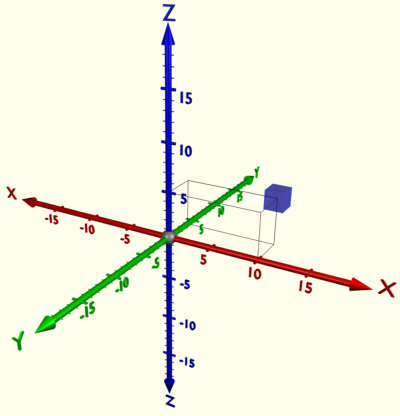What are the fundamental
principles behind the creation of virtual 3D space? Describe and explain 3D
geometry.
Remember that you are
trying to comprehensively explain the theory and applications of 3D with
elucidated examples and consistently using subject terminology correctly.
Geometry
Geometry
Many modeling programs do not strictly enforce geometric
theory; for example, it is possible for two vertices to have two distinct edges
connecting them, occupying exactly the same spatial location. It is also
possible for two vertices to exist at the same spatial coordinates, or two
faces to exist at the same location. Situations such as these are usually not
desired and many packages support an auto-cleanup function. If auto-cleanup is
not present, however, they must be deleted manually.

The creator of the Cartesian Coordinates System, is by René Descartes who revolutionized mathematics by providing the first systematic link between Euclidean geometry (from the Classical Greek mathematician Euclid of Alexandria) and algebra (where letters and other general symbols are used to represent numbers and quantities in formula and equations).
Source:http://upload.wikimedia.org/wikipedia/commons/7/73/Frans_Hals_-_Portret_van_Ren%C3%A9_Descartes.jpg

Geometric Theory and Polygons
Cartesian Coordinates System
A Cartesian coordinate system is a coordinate system that
specifies each point uniquely in a plane by a pair of numerical coordinates,
which are the signed distances from the point to two fixed perpendicular
directed lines, measured in the same unit of length. Each reference line is
called a coordinate axis or just axis of the system, and the point where they
meet is its origin, usually at ordered pair (0, 0). The coordinates can also be
defined as the positions of the perpendicular projections of the point onto the
two axes, expressed as signed distances from the origin.

The creator of the Cartesian Coordinates System, is by René Descartes who revolutionized mathematics by providing the first systematic link between Euclidean geometry (from the Classical Greek mathematician Euclid of Alexandria) and algebra (where letters and other general symbols are used to represent numbers and quantities in formula and equations).
Source:http://upload.wikimedia.org/wikipedia/commons/7/73/Frans_Hals_-_Portret_van_Ren%C3%A9_Descartes.jpg

Geometric Theory and Polygons
The basic object used in mesh modeling is a vertex, a point
in three dimensional space. Two vertices connected by a straight line become an
edge. Three vertices, connected to each other by three edges, define a
triangle, which is the simplest polygon in Euclidean space. More complex polygons
can be created out of multiple triangles, or as a single object with more than
3 vertices. Four sided polygons (generally referred to as quads) and triangles
are the most common shapes used in polygonal modeling. A group of polygons,
connected to each other by shared vertices, is generally referred to as an
element. Each of the polygons making up an element is called a face.
In Euclidean geometry, any three non-collinear points
determine a plane. For this reason, triangles always inhabit a single plane. This
is not necessarily true of more complex polygons, however. The flat nature of
triangles makes it simple to determine their surface normal, a
three-dimensional vector perpendicular to the triangle's surface. Surface
normal's are useful for determining light transport in ray tracing, and are a
key component of the popular Phong shading model. Some rendering systems use
vertex normal s instead of face normal's to create a better-looking lighting
system at the cost of more processing. Note that every triangle has two face
normal's, which are on the same line but opposite from each other. In many
systems only one of these normal's is considered valid – the other side of the
polygon is referred to as a backface, and can be made visible or invisible
depending on the programmer’s desires.
Source:http://en.wikipedia.org/wiki/Geometric_primitive
Geometric Surfaces
Source:http://en.wikipedia.org/wiki/Geometric_primitive
Geometric Surfaces
In mathematics,
specifically, in topology, a surface is a two-dimensional, topological
manifold. The most familiar examples are those that arise as the boundaries of
solid objects in ordinary three-dimensional Euclidean space - for example, the
surface of a ball. On the other hand, there are surfaces, such as the Klein
bottle, that cannot be embedded in three-dimensional Euclidean space without
introducing singularities or self-intersections.
To say that a surface
is "two-dimensional" means that, about each point, there is a
coordinate patch on which a two-dimensional coordinate system is defined. For
example, the surface of the Earth is a two-dimensional sphere, and latitude and
longitude provide two-dimensional coordinates on it.
The concept of
surface finds application in physics, engineering, computer graphics, and many
other disciplines, primarily in representing the surfaces of physical objects.
For example, in analyzing the aerodynamic properties of an airplane, the
central consideration is the flow of air along its surface.
Source:http://pushkarjoshi.org/img/JS_CAGD_2010_teaser.jpg
Primitives
The term geometric primitive in computer graphics and CAD systems is used in various senses, with the common meaning of the simplest geometric objects. A common set of two-dimensional primitives includes lines,
points, and polygons, although some people prefer to consider triangles
primitives, because every polygon can be constructed from triangles. All other
graphic elements are built up from these primitives. In three dimensions,
triangles or polygons positioned in three-dimensional space can be used as
primitives to model more complex 3D forms. In some cases, curves may be considered primitives, in other cases,
curves are complex forms created from many straight, primitive shapes.


No comments:
Post a Comment